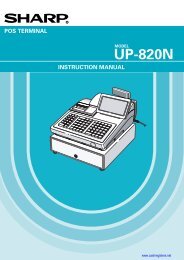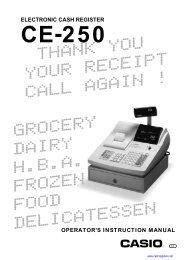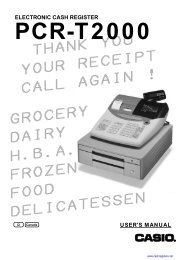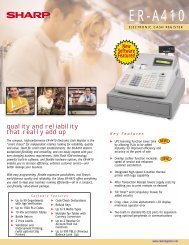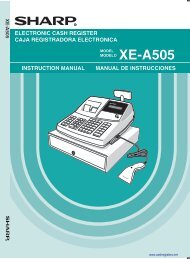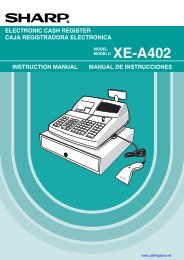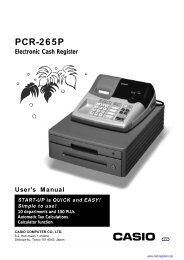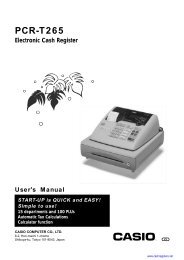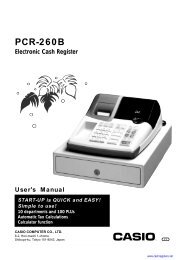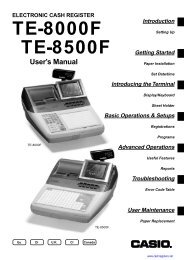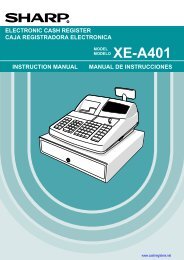2 - Cash Registers
2 - Cash Registers
2 - Cash Registers
Create successful ePaper yourself
Turn your PDF publications into a flip-book with our unique Google optimized e-Paper software.
30<br />
One- or two- *1 *2<br />
Rate s 8 @ @ @ M @<br />
To delete a tax table, use the following sequence:<br />
One- or two- *1 *2<br />
Rate s 8 @ @ @ M @ s<br />
*1 First figure:<br />
(1 or 0)<br />
Second figure:<br />
(1 to 4)<br />
The first figure to be entered depends upon whether the difference between a minimum<br />
breakpoint to be entered and the preceding minimum breakpoint is not less than $1.00 or<br />
more than 99¢. When the difference is not less than $1.00, enter “1,” and when it is not more<br />
than 99¢, enter “0” or nothing.<br />
The second figure depends upon whether your tax table is to be programmed as tax table 1,<br />
2, 3 or 4.<br />
*2 If the rate is fractional (e.g. 4-3/8%), then the fractional portion (3/8) would be converted to its decimal<br />
equivalent (i.e. .375) and the resulting rate of 4.375 would be entered. Note that the nominal rate (R) is<br />
generally indicated on the tax table.<br />
If you make an incorrect entry before entering the M in programming a tax table, cancel it with the<br />
l key; and if you make an error after entering the M, cancel it with the s key. Then program<br />
again from the beginning.<br />
• Limitations to the entry of minimum breakpoints<br />
The register can support a tax table consisting of no more than 72 breakpoints. (The maximum number of<br />
breakpoints is 36 when the breakpoint difference is $1.00 or more.) If the number of breakpoints exceeds the<br />
register’s table capacity, then the manual entry approach should be used.<br />
Example: Programming the sample tax table shown on the previous page as tax table 1<br />
Key operation example<br />
Print<br />
Tax rate<br />
M<br />
T<br />
Q<br />
The first<br />
cyclic<br />
portion<br />
M1<br />
(MAX point)<br />
digit number<br />
s 8 @<br />
1 @<br />
6 @<br />
100 @<br />
1 @<br />
11 @<br />
23 @<br />
39 @<br />
57 @<br />
73 @<br />
89 @<br />
111 @<br />
A<br />
digit number<br />
max. six digits<br />
(0.0001 - 99.9999%)<br />
max. six digits<br />
(0.0001 - 99.9999%)<br />
max. four<br />
digits<br />
max. four<br />
digits<br />
Minimum breakpoint<br />
T @ Q @ max. five digits @ A<br />
max. three<br />
digits<br />
max. five<br />
digits<br />
Repeat until the MAX point is entered.<br />
You do not need to enter the trailing zeros of the tax rate (after the decimal point) but you do need<br />
to enter the decimal point for fractions.<br />
www.cashregisters.net



